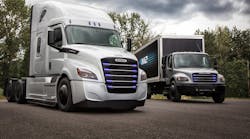In the next move for its electric trucks announced in early June, Daimler Trucks North America (DTNA) said that Penske Truck Leasing and third-party logistics provider NFI will be putting the heavy-duty Freightliner eCascadia and medium-duty eM2 106 into use later this year.
It's part of a "co-creation" process where DTNA will evaluate and optimize the electric trucks' performance "to meet the most valid target applications," according to the company. Penske will begin taking delivery of 10 eCascadia and 10 eM2 106 trucks toward the end of 2018, and those will be used in California and northward along the Pacific Coast.
NFI will get 10 eCascadias for drayage service, hauling loads from the ports of Los Angeles and Long Beach to warehouses in California's Inland Empire region in the south of the state. Upon its unveiling, DTNA said the eCascadia can be built with a range of up to 250 miles and can be recharged to 80% battery capacity in 90 minutes.
The lighter eM2, which is aimed at applications such as local distribution, pickup and delivery, food and beverage delivery, and last-mile logistics operations, will offer a range up to 230 miles and 80% recharging capability in an hour, according to DTNA.
"Running multiple trucks in real-world applications will provide better insights for our engineers into the requirements of integrating electric commercial vehicles into fleet operations," said Roger Nielsen, president and CEO of DTNA. "We are partnering with these two customers for this phase of the co-creation process because they have use cases that closely fit the target applications we have identified."
DTNA is also forming an Electric Vehicle Council to work with fleet customers for whose operations the electric Freightliners could be a fit. The council will share what's learned from the eCascadia and eM2 in use, as well as from the DTNA engineers' evaluations of the trucks.
The electric Freightliner trucks will go into production in 2021, DTNA has said. Further, "as testing progresses, the DTNA Electric Vehicle Council will discuss planned product offerings to gather candid feedback as the OEM moves toward commercialization of electrified trucks," the company noted.
Heavy-duty trucks "present the greatest engineering challenges" for electric power, noted Richard Howard, senior vice president of sales and marketing at Freightliner Trucks—particularly given North American duty cycles and longer range requirements. Even so, "electric commercial vehicles present a real opportunity to reduce emissions and enhance our customers' bottom lines through improved uptime and lower operating costs," he said.
The DTNA team will take a "holistic" approach with potential electric vehicle users, consulting with them on the necessary charging infrastructure, operating the vehicles, and service and maintenance.



